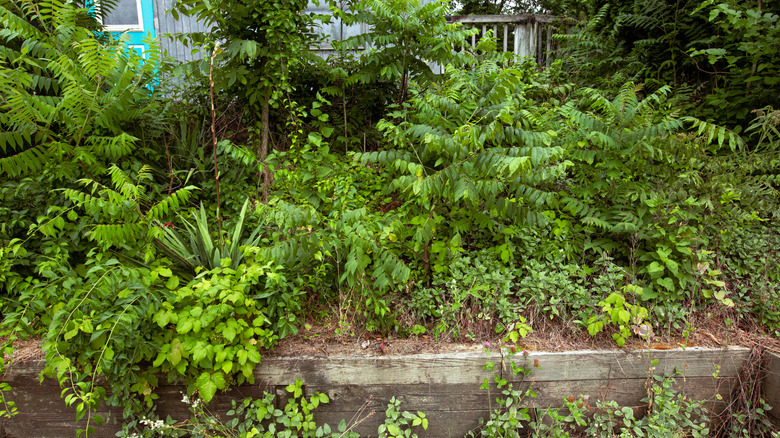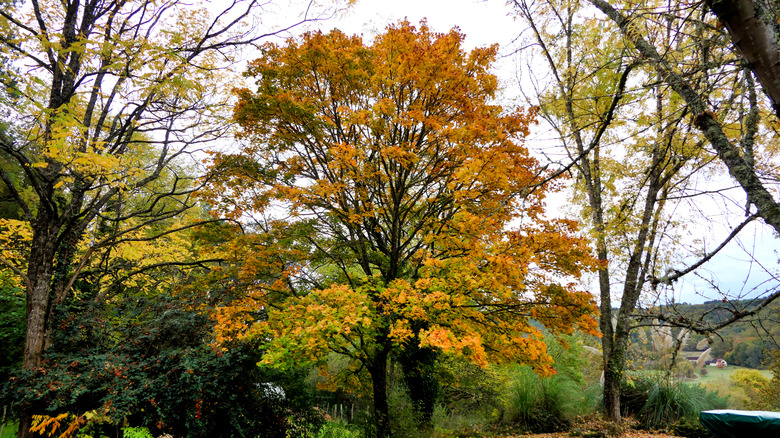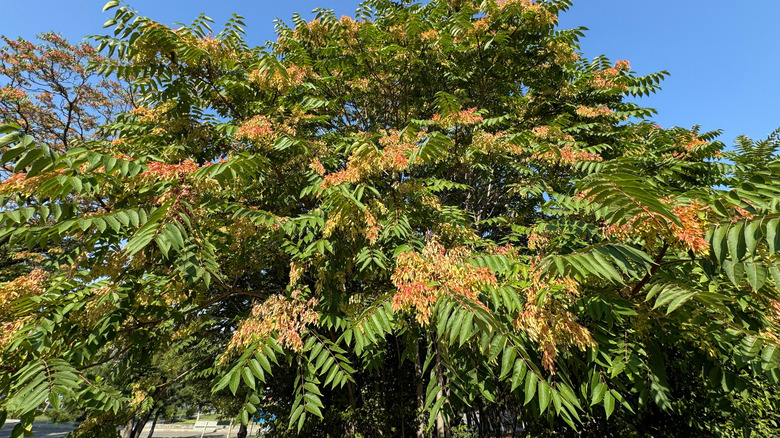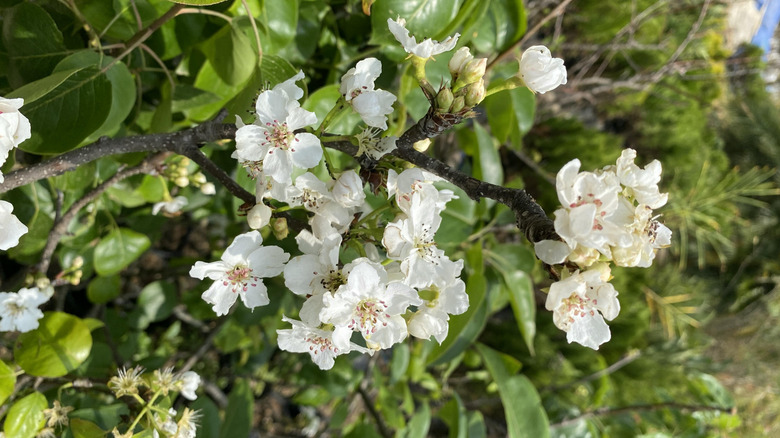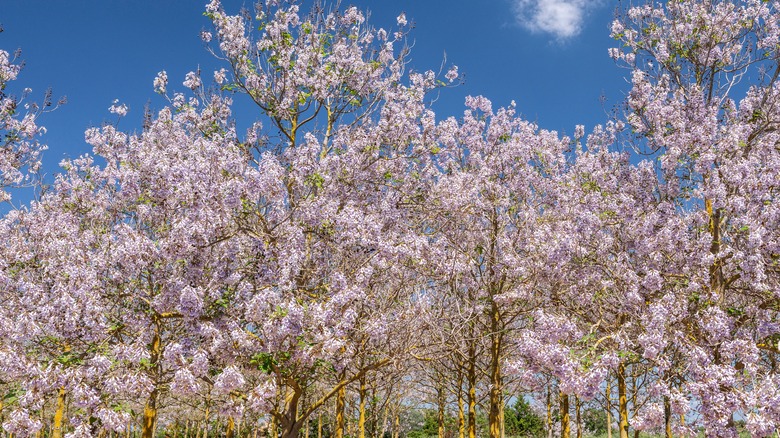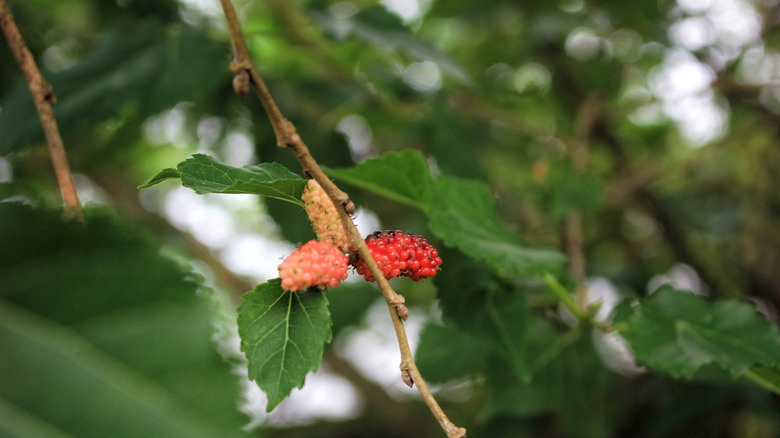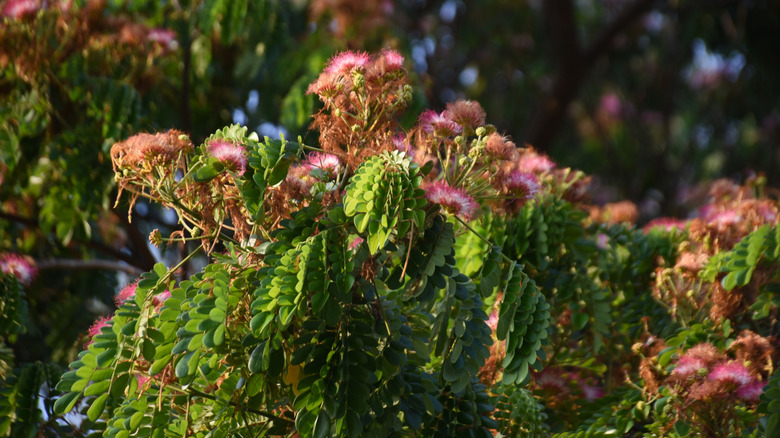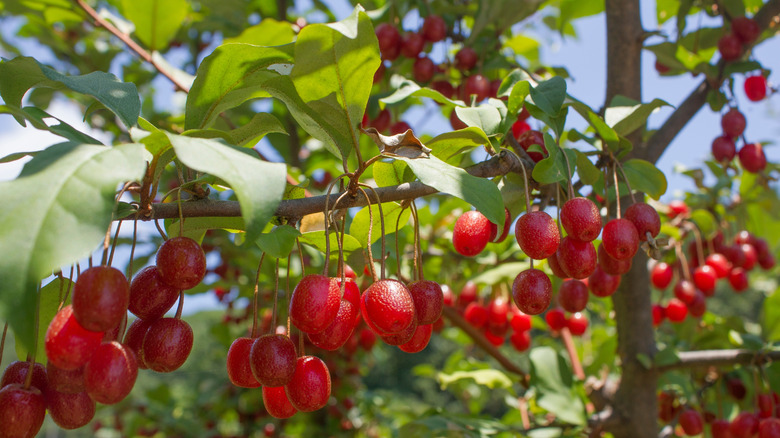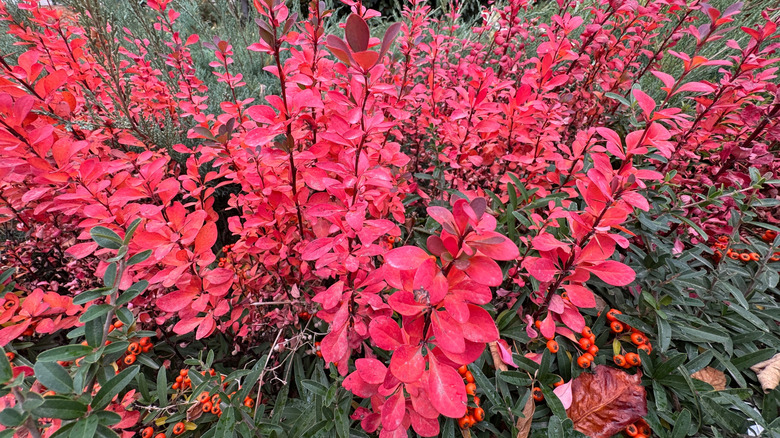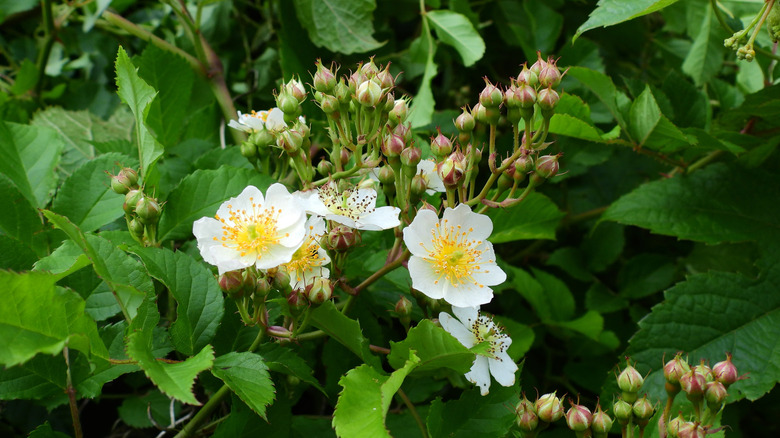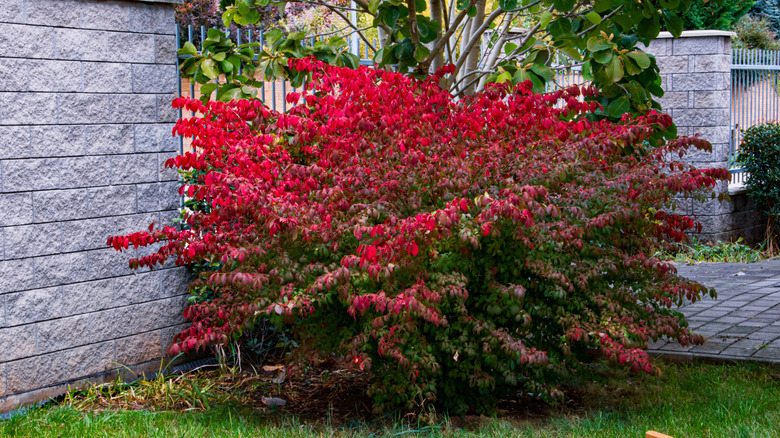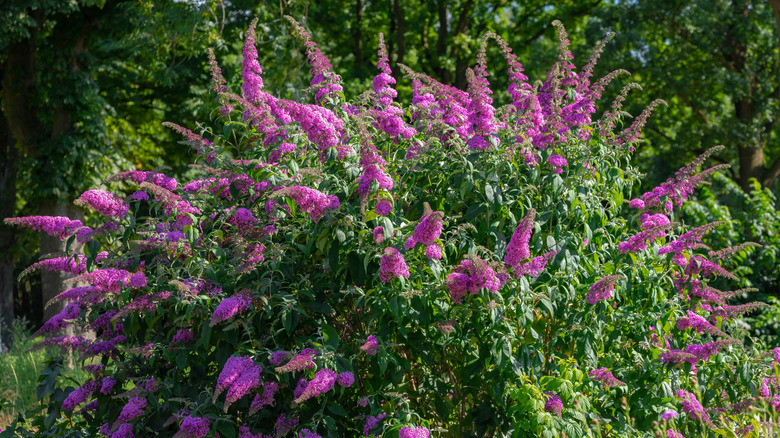The Most Invasive Trees And Shrubs On The East Coast To Avoid Planting At All Costs
When designing your dream garden, you may be drawn to plants offering vibrant blooms, striking foliage and flowers, and wildlife benefits. Unfortunately, some of the most attractive plants at the local garden center can harbor invasive tendencies that damage natural ecosystems. Keep in mind, invasive plants don't simply refer to weedy or aggressive species. Instead, they're non-native, introduced species that slip past their cultivated boundaries and compete with the local biodiversity.
Today, invasive plants have caused the decline of over 18% of the threatened and endangered species in the U.S. Their success stems from profuse seed production, broad adaptability, and aggressive root systems. Since urban and suburban gardens often serve as launching pads for these plants to spread into natural areas, the only way to prevent further environmental damage is to not plant them.
Focusing on the East Coast region from Maine to Virginia (including Pennsylvania), the most invasive species you must be wary of include Norway maple, white mulberry, mimosa, burning bush, and butterfly bush. So, it's important to know what makes them invasive and what you could plant instead.
Norway maples have altered the native forests in many eastern states
You may mistake Norway maples (Acer platanoides) occupying open spaces as natives. After all, they look similar to local red and sugar maples. Planted across urban landscapes for shade (and sometimes as replacements for dead elm trees), Norway maples are prized for their striking form. Plus, they can withstand extreme soil conditions, including clay and compaction. However, you should avoid growing them, as they've become highly invasive throughout the East Coast, from Maine to Virginia.
While all maple trees produce winged samaras or helicopter seeds, Norway maples generate them in large numbers. The problem worsens because these maples grow and produce faster than native ones. Plus, these introduced trees green up earlier in spring, eclipsing the seedlings underneath their dense canopies. This suppresses spring bloomers like wildflowers and other native vegetation, potentially reducing food resources for resident birds and wildlife. Put simply, they're bad news for the local biodiversity.
If you appreciate the classic look of Norway maples, choose native alternatives instead. Options include sugar maples (Acer saccharum), red maples (Acer rubrum), and bigleaf maples (Acer macrophyllum). You could even opt for Freeman maple (Acer x. freemanii) — a hybrid of red and silver maple.
Tree-of-heaven is invasive along the East Coast
Since its introduction to the U.S. during the late 1700s, tree-of-heaven (Ailanthus altissima) has been widely planted across the East Coast. It grows rapidly, appears attractive when shaped, and thrives in challenging conditions where urban pollution, poor soil, extreme heat, or drought would harm many trees. Yet, you should think twice about planting a tree of heaven anywhere near your home. This is because every state plant council from Maine to Virginia has classified it as an invasive species.
Since one tree-of-heaven can spread suckers 50 feet away, it pops up in unwanted places and establishes dense colonies. Female trees can produce over 300,000 seeds every year. These lightweight seeds can travel up to 300 feet in the wind. These aggressive characteristics allow the species to take over vulnerable forest areas and disrupt the local ecosystem as native plants lose out in the resource competition. Native flora must also contend with tree-of-heaven's harmful toxins, including "ailanthone," which inhibit nearby species. To add insult to injury, tree-of-heaven hosts spotted lanternflies, an invasive pest that can decimate grape and fruit orchards. These trees can also trigger allergies due to their high pollen production.
In place of tree-of-heaven, consider planting staghorn sumac (Rhus typhina), green ash (Fraxinus pennsylvanica), or butternuts (Juglans cinerea) in your yards. They exhibit similar visual appeal but are native to the region.
Callery pears disrupt the native ecosystems in several states
You've probably marveled at the sight of Callery pears (Pyrus calleryana) — or their famous cultivars 'Bradford,' 'Aristocrat,' and 'Cleveland Select'— framing sidewalks with white spring blooms. You may have even considered adding them to your landscape, given their appealing qualities. They don't produce any messy fruit, survive in compacted soil, and offer gorgeous red fall colors. However, you should reconsider your choice because these introduced trees and their cultivars are listed as invasives in many eastern states.
When planted in proximity, even different varieties of Callery pear cultivars cross-pollinate. As many of them are grafted, an especially vigorous rootstock can sometimes sprout new shoots. After birds digest their fruits, they expel the seeds which quickly germinate and take over natural areas. Callery pears green up earlier and hold their leaves longer than native trees, thus shading them out and clearing out understory vegetation. They also release chemicals into the ground that can prevent nearby native seeds from germinating.
Instead of Callery pears, consider planting Alleghany serviceberry (Amelanchier laevis) or its cultivars 'Cumulus' and 'Rogers.' These offer spectacular spring flowers, fall displays, and wildlife-friendly winter berries. But if you're specifically seeking tough trees that tolerate a variety of conditions, go with eastern redbuds (Cercis canadensis).
Princess tree is invasive in states from Maine to Virginia and is on New Hampshire's watchlist
The princess tree (Paulownia tomentosa), also known as the empress tree or royal paulownia, is a beautiful tree you'll regret planting near your home. Granted, it enhances spring landscapes with large, violet flowers and can do well in water-stressed sites carrying acidic, infertile soils. But its ornamental qualities don't justify its planting. Princess trees have overtaken sites on the East Coast, especially in southeast Pennsylvania, Delaware, Maryland, and Virginia.
These trees naturalize in disturbed areas with seeds and sprouts. A lone tree can produce over 20 million seeds a year. These are contained in pods of about 2,000 seeds each that are dispersed widely through winds and water. Then, the new sprouts can grow over 15 feet in the growth season. As you can imagine, having them on your property can be an issue, as their extensive root systems can damage foundations and structural elements.
Instead of the princess tree, opt for the Kentucky coffee tree (Gymnocladus dioicus), an eastern U.S. native that tolerates drought and urban settings. For flowering displays rivaling Princess trees, choose flowering dogwoods (Cornus florida) or redbuds (Cercis canadensis). Pawpaw trees (Asimina triloba) are another native fruiting alternative.
White mulberry has invaded natural areas in several east coast states
White mulberry (Morus alba) trees were originally planted along the Atlantic coast by colonizers. However, they made their way into residential landscapes throughout the region. They grew fast, adapted to varying conditions, and resisted drought, wind, and salt. Swathed in glossy leaves, they are attractive to birds that nibble on their berries. Unfortunately, they are very aggressive and quickly grew invasive.
White mulberry trees spread through their distinctively orange roots. They also depend on birds and small mammals to disperse their seeds, which they produce in millions during their lives. Over time, they've spread throughout natural areas, edging out native vegetation. For example, they spread diseases to red mulberry trees that damage their roots.
Fortunately, there are better alternatives to grow instead of white mulberry trees that can be just as attractive. These include red mulberry (Morus rubrum), black cherry (Prunus serotina), or wild plum (Prunus americana) trees, which provide edible fruits for you and the birds. For similar physical attributes, choose sassafras (Sassafras albidum) or red maple (Acer rubrum).
Mimosa trees displace the native vegetation in spots like Pennsylvania and Virginia
The charms of mimosa trees (Albizia julibrissin), or silk trees, are obvious. They look spectacular when their wispy pink blooms dance above fern-like foliage in spring. However, you might want to rethink growing a mimosa tree in your yard, as they're classified as invasive in many states along the coast.
Mimosa trees might be short-lived, but their negative impacts aren't. They produce abundant seeds with a tough outer coating that can remain viable in the soil for several years. These seeds can stray hundreds of feet from their parent tree in strong winds, though they also move via water and mammals. This explains why the trees spring up randomly along roadsides and on vacant lots. Also, their dense canopies block sunlight from reaching native understories, stunting their growth. Sadly, cutting mimosas down provides little respite because they resprout swiftly, gaining over 3 feet in a season.
Given these reasons, avoid planting mimosa and opt for fragrant mimosa (Mimosa borealis) instead. It produces similar puffy pink blooms atop thorny foliage, delighting pollinators. Eastern redbuds (Cercis canadensis) and witch hazel (Hamamelis virginiana) also make outstanding replacements if you're looking for something taller.
Autumn Olive impedes native plant succession in the East Coast region
Silvery leaves, pale yellow blooms, and red berries that attract birds — what's not to like about Autumn Olive (Elaeagnus umbellata)? Unfortunately, this beautiful fruit-bearing tree is actually invasive. Although often planted across the East Coast to add beauty to landscapes and as wind barriers, Autumn Olives have since gained a foothold in areas from Maine to Virginia.
Several factors enable Autumn Olive's aggressive spread. For a start, they produce numerous seeds that fruit-eating wildlife happily distribute far and wide. These shrubs adapt easily to various conditions, including highly acidic soils, allowing their seeds to germinate successfully in most environments. Once established, they're extremely difficult to eradicate. In fact, cutting or burning them actually stimulates their spread.
Autumn Olive's fruits aren't as nutritious for wildlife as native berries. Instead, you should grow chokeberries (Aronia spp.), winterberries (Ilex verticillata), or American cranberry bush (Viburnum opulus var. Americanum). For an equally ornamental, yet low-maintenance tree, plant soapberry (Sheperdia canadensis).
Japanese barberry is invasive in the Eastern United States
Japanese barberry (Berberis thunbergii) shrubs are prized as compact hedges that beautify the landscape with their colorful, spoon-shaped foliage and winter-persisting red berries. Gardeners appreciate their tolerance for drought and shade. However, you should think twice before planting Japanese barberry in your garden because they're invasive in many eastern states.
These plants produce seeds that can readily germinate in various environments after being transported by wildlife like birds and rabbits. They also spread through underground roots and sprout upwards, taking over areas. The thick coverage that they establish deprives lower native plants of essential nutrients and light. Thus, they've become invasive throughout the East Coast.
So, save yourself the trouble, and consider native alternatives. Inkberry hollies (Ilex glabra) make excellent living hedges, while winterberries (Ilex verticillate) provide wildlife benefits. For areas with wet soil, try low-maintenance alternatives like Virginia Sweetspire (Itea virginica) or Gray Dogwood (Cornus racemosa).
Multiflora rose ousts native flora up and down the coast
You might have seen the white blooms of multiflora roses (Rosa multiflora) lining roadways. Perhaps, you've noticed robins and cedar waxwings eagerly nibbling their rose hips, making you think you could bring birds to your yard by adding the plant. However, you should think again as multiflora roses are invasive throughout the East Coast.
Multiflora roses spread so quickly by producing tons of seeds, (some estimates put the figures in millions). Interestingly, the plant's seeds germinate better after birds digest them, allowing them to spread more effectively. Seeds that don't sprout immediately can remain viable in the soil for nearly 20 years. They are also highly adaptable, allowing them to survive and spread in a variety of natural areas, ousting native plants. Plus, by developing new roots when their drooping canes touch the soil, they form dense thickets that wildlife can struggle to move through.
Considering their invasive potential and relatively low nutritional value for local birds, it's best to choose native roses instead. Virginia (Rosa virginiana) and swamp (Rosa palustris) are two great options. But if you prefer white flowers, scarlet mallow (Hibiscus laevis) may be more suitable.
Burning bush is invasive in many east coast areas
Also known as wahoo and winged spindle tree, burning bush (Euonymus alatus) has been a popular choice in landscapes since its introduction to the U.S. in the 1800s. Its fall colors are spectacular, enhanced further by bright red fruits and distinctive winged stems. However, burning bushes have invaded natural areas over time, including forests across the East Coast, upending native ecosystems.
The invasive spread of burning bushes is primarily fueled by seeds. As their attractive fruits are available in the winter, birds and mammals consume them to survive the season. Being highly adaptable to diverse conditions, including full shade and extreme soil pH levels, the excreted seeds eventually grow into dense thickets, crowding out native herbs and shrubs. You may find multiple seedlings beneath established plants, creating what botanists call a "seed shadow."
Good alternatives for invasive burning bush plants in the garden include black chokeberry (Aronia melanocarpa), highbush blueberry (Vaccinium corymbosum), and highbush cranberry (Viburnum trilobum), for their blazing red fall colors and bird-friendly berries. 'Brilliantissima,' a cultivar of red chokeberry (Aronia arbutifolia), rivals burning bush's fall hues. In challenging sites, spicebush (Lindera benzoin) may work well, though it glows bronze in the fall.
Butterfly bush impairs the native ecosystems of eastern states
If you're concerned about declining butterfly populations and want to support them, planting butterfly bush (Buddleja davidii) is not the answer. The truth is it offers limited benefits to butterflies despite its name and reputation. Fluttering pollinators visit butterfly bushes when their pretty blooms are brimming with nectar. But when it's time to lay eggs, they're passed over because caterpillars can't survive on their leaves. So, they neither help rebuild the butterfly population nor support birds (like chickadees) that depend on caterpillars and insects for survival. To make matters worse, butterfly bush is invasive on the East Coast.
Butterfly bushes flower so profusely that their branches often arch down under their weight. Such carefree flowering produces plentiful dust-like seeds that travel wide distances through wind or water. So it's not a surprise that they've invaded and overwhelmed the native vegetation in many areas. This invasion further deprives the native wildlife, including butterflies, of crucial food and larval host sources. Additionally, they attract pollinators away from indigenous plants, reducing their pollination and may even facilitate the spread of pests like brown marmorated stink bugs.
So, to truly benefit pollinators, look for plants like buttonbush (Cephalanthus occidentalis) because they host Lepidoptera butterflies. Butterfly-weed (Asclepias tuberosa) is also important for monarch butterflies to have a spot to lay their eggs. You could even add spicebush (Lindera benzoin) to your yard if you'd like to host swallowtails.
